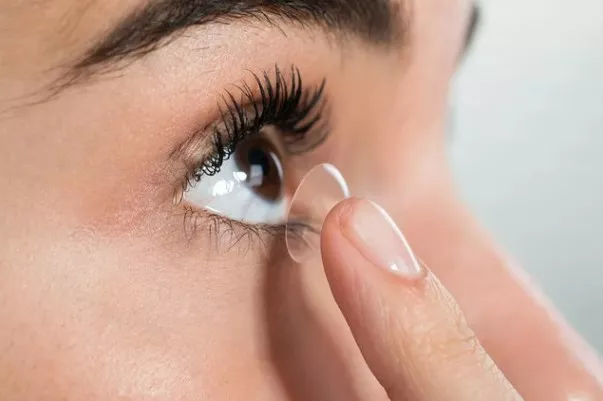Jul 3, 2023

Wearing contact lenses is nothing new for image-conscious Hong Kongers. However, the large number of wearers does not necessarily mean that they understand the proper way to use contact lenses. There has been an online myth that "contact lenses can only be worn for 10 years from the first time they are worn, or they will damage your eyes." Is this myth true or false? Ophthalmologist Dr. Chan Cheuk Ki will answer various questions about wearing contact lenses.
Dr. Chan Cheuk Ki pointed out that, in fact, there is no such thing as a 10-year or 20-year limit on wearing contact lenses. Whether a person can continue to wear contact lenses depends on their individual physical condition and lifestyle. If the wearer has sufficient tear production and does not experience issues such as corneal hypoxia, dry eyes, itching, or sensitivity due to wearing contact lenses, people who have worn contact lenses for more than 10 years, or even elderly individuals, can continue wearing them. On the other hand, if there is any discomfort caused by wearing contact lenses, one should immediately consult an ophthalmologist to check the condition of the lenses and determine if they are still suitable for continued use.
Dr. Chan explained that when wearing contact lenses, the lenses cover the cornea, creating a barrier to oxygen transmission. The oxygen permeability rate is the measure of this barrier—the higher the value, the more oxygen can pass through. Insufficient oxygen permeability can lead to corneal hypoxia. Long-term corneal hypoxia causes conjunctival blood vessels to grow toward the edge of the cornea, leading to corneal edema and inflammation, causing pain, tearing, and sensitivity to light. In severe cases, corneal scarring may occur, preventing further contact lens use and potentially causing permanent vision damage.
Although higher water content in contact lenses generally leads to higher oxygen permeability and a lower foreign body sensation, it also means that moisture evaporates faster. If the wearer does not have enough tear production to supplement the moisture needed by the lenses, it can result in a dry sensation, eye redness, or even corneal hypoxia due to insufficient oxygen permeability.
Overly dry lenses can scratch the corneal surface, so wearers must pay attention to tear secretion when selecting lenses, choosing those with high oxygen permeability but not excessively high water content to avoid discomfort.
In the past, most contact lenses were either monthly or yearly disposables. As the names suggest, monthly lenses can be used for up to a month under proper use and cleaning, while yearly lenses can be used for up to a year.
Dr. Chan emphasized that daily disposable contact lenses must be discarded after one day's use. Reusing daily disposables can reduce oxygen permeability and degrade the material, making them unsuitable for further use. Repeated use of daily disposables can lead to dryness, redness, corneal hypoxia, corneal edema, and blood vessel growth, causing further damage to the eyes.
When putting on and removing contact lenses daily, there is a risk of accidentally scratching the cornea with the lens or a fingernail. Serious cases can result in symptoms such as redness, stinging, light sensitivity, and blurry vision. Generally, corneal surface damage will heal naturally within a few days, but it is essential to stop wearing contact lenses during this time. Following the ophthalmologist's diagnosis and prescription, antibiotic eye drops should be used to prevent infection and help the cornea heal quickly. If discomfort persists or worsens, consult an ophthalmologist for further examination.
Dr. Chan explained that the surface of the eye is covered by a thin membrane connecting the corneal edge and the inner eyelid, so contact lenses cannot slip behind the eye. From a physiological perspective, it's impossible for contact lenses to move to the back of the eye.
However, after vigorously rubbing their eyes and losing sight of their contact lens, people may repeatedly touch their eyeballs with their fingers in an attempt to find the missing lens, causing scratches on the corneal surface and a foreign body sensation. Even if the lens is eventually found, the damage has already been done.
The correct approach is to first use saline solution or artificial tears, then move the eyes up, down, left, and right to locate the uncomfortable area where the lens is likely stuck. Gently pull the eyelids apart and ask someone to help find the lens. If it still cannot be found, seek help from an ophthalmologist.
Wearing contact lenses while sleeping should also be avoided, as this can lead to corneal hypoxia and inflammation.
Likewise, avoid wearing contact lenses while barbecuing or eating hot pot, as the heat can cause the lenses to dry out and stick to the cornea. Although the lenses do not melt, avoid forcibly removing them, as this can injure the cornea. Instead, rinse your eyes with plenty of saline or contact lens solution, and gently remove the lenses. If the problem persists, seek an ophthalmologist's help.
Your eyes are the windows to your soul. Don’t sacrifice your eye health for convenience. Handle
